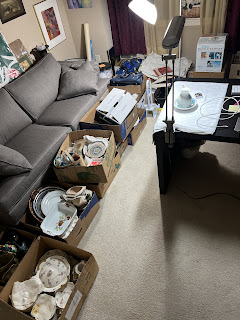eBay Pricing - How Do I Price Listings?
How do I Price listings? First I have to admit that there is not really a specific strategy that applies to everything. Factors which play into it:
- Condition
- Presence of original packaging / box and its condition
- How much the shipping will be (I don’t do free shipping)
- Is it an exceptional listing that represents the brand?
- Emotional value (to me or Zabrina), do we want it for display in our house for a while?
- Rarity or saturation
- Past experience with item or category
- Comps
- Sales history (myself and other sellers)
- How many similar items like it do I have?
First off, let me say that, the more I do this, the more that I am improving and find I can do more pricing with minimal or no lookup. Once I a price an item, it absolutely is not set in stone but fluid based on number of watchers over time; the cost I paid (which really only influences higher value pricing) is rarely an influencing factor as I look at the cost of a whole lot and not single items. So some items might just get my cost or less and others more significant profit.
The cost of an item most often plays little part because I gauge profit at a lot level and not at a specific item level. Let’s say that I paid $100 for a lot of merchandise at auction or an estate sale…or even during the course of a day or weekend. My goal is at a minimum to yield 200% profit out of the lot over time, not necessarily in the short term and not for each individual item. So using the example, I want a minimum of $300 in listings. Some may sell at below cost and others well above…I sometimes pay too much, but no longer worry too much about it because I am continually improving on my picking as is Zabrina. Remember that on average fees and item cost exceed 35% of total gross revenue, meaning approximately 15-18% in eBay selling fees and 20% on shipping costs. So selling $100 in listing yields a gross revenue of maybe $500, but after fees and shipping are deducted I am down to $325, and less the cost of $100, my profit would be roughly $225. That’s the overall simple math anyway and you would be shocked at how much I pay monthly for shipping supplies which isn’t included.
Of course, I like to ensure the buyers feel they got a fair price (at worst) and a great price (at best) so whenever possible I try to price listing below the market competition (comps and past sales history) for similar product and condition. Given that my sourcing is constantly improving and buying at lower and lower cost, this is not a big challenge with few exceptions and only improving.
Two key attributes of an item are highly attractive to me are condition and original packaging/box. Those two thing will allow me often to get a premium price, even while pricing below similar competitor items and even if there is high saturation out there. There are always those listing that one finds 10s if not 100s of competitive listings out there, so one needs to differentiate on price, condition, or completeness/packaging.
Now for large items like pictures, vacuum cleaners, or items over 10 pounds I have to consider the shipping that will need to be paid by the buyer, so often have to price those items lower than normal, but will get some compensation from shipping discount which can approach 40% or 50% if using UPS Ground. But remember, it’s all about a wider pricing strategy and that shipping discount benefit is just a factor, not a bonus as it might sound because the item price will often be reduced to compensate and these larger items take more supplies to pack.
Let’s talk a little about exceptional listings that represent the brand I am trying to build best, those unicorn or highly rare collectible items that are so unique, there is value in just having the listing. Examples are the Weaver Gallery Steve Steigman Porsche poster or the 99.9% Sterling Demitasse set with stunning packaging. Often these are also items which Zabrina or I may have an emotional attachment to, but not always….but, the influence on pricing is identical, in that those are listing I price well above market as I take pride in the listing value or take pride in having the item in my home - so if someone wants the item, they will have to pay a premium. These are sometimes investment items and help drive customers to the store, although sure there is a negative component too that they perceive I price way over market…but I am ok with the trade off for now.
I think I have hit on most of the key factors that help me determine pricing. At the end of the day this is a cycle that continually feeds my experience and ability to determine an items sale price quickly without having to always refer to the eBay app when buying which I rarely do. I am ok making some mistakes and paying too much for something because the buying experiences leave a permanent impression and learning. I am sure there are other “gut” factors that play into it as well, but these are the basics.
John




Comments
Post a Comment
No URLs, I delete comments which appear to be be advertising.